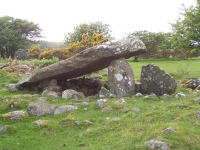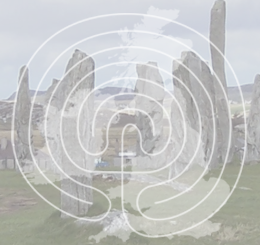Holy Well of St Winifred
The healing waters of St Winifred’s (Winifride) Holy Well have attracted pilgrims for over 1300 years and the crypt in which the well lies was stacked with crutches left by the cured invalids until some time in the 1960’s, though can still be seen on display.
Gwenfrewi or Gwenffrwd (St Winifred) was a chaste young Welsh woman of noble birth who had chosen to devote her life to the service of God. In 660AD Caradoc (or Caradog), a local chiefs son lusted after the young nun, who, true to her vows of chastity always managed to repulse his advances, until one day, whilst drunk, he attacked her in her home and started to tear away her clothes. She fled towards her uncle’s (St Beuno) church, hoping that he would be able to aid her, but Prince Caradoc was quicker and caught her on a hillside. Winifred fought back, so Caradoc, in a fit of rage beheaded her with his sword. St Beuno had been inside the church and came outside to find Winifred’s decapitated corpse with Caradoc stood over her. A spring had welled up from the ground at the spot where Winifred had fallen, a true gift from God. St Beuno then cursed Caradoc, who immediately died and melted. Being a gifted man himself, St Beuno replaced St Winifreds head on her neck, and after a short prayer the wound was healed and the young woman was resurrected, leaving only a slight scar. St Bueno then cursed the family of Caradoc who started to bark as if they were hounds. They could only be cured if they bathed in the healing water of the well created at the site of Winifred’s attempted rape and murder. Red marked stones at the bottom of the well are said to be stained with blood of St Winifred, who’s remains have been in Shrewsbury Abbey in 1138. Winifred actually died though at Gwytherin where she had become Abbess and where her body had been laid to rest become moving her to Shrewsbury.
Apparently in the 1880’s the spring fed Well reputedly discharged twenty tons of water or three thousand gallons per minute at a temperature of 50 degrees. Early in the 20th century the well dried up due to mining on Halkyn Mountain as the water was diverted. The well today is fed by the local water utilities so it will not have the same mineral properties as thse the early pilgrims would have taken advantage of.
The Well has been a place of pilgrimage since the 7th century and many notables have visited it’s healing waters, including Richard I (before departing on the crusade), James II, Henry V, Dr. Samuel Johnson ( who remarked on indecency of a woman bathing there) and supposedly by those involved in the Gunpowder Plot.
Obviously the tale of Winifred being resurrected could not have physically happened, but the legend may have some links to actual events. Winifred was related to the Royal house of Powys and I found a reference that her brother, Owain, was said to have killed Caradoc in act of vengeance.
An anonymous rhyme written in the 18th Century names St Winifreds Well as one of the Seven Wonders of Wales:
Pistyll Rhaeadr and Wrexham steeple,
Snowdon’s mountain without its people,
Overton yew trees, St Winefride wells,
Llangollen bridge and Gresford bells.





Re: Holy Well of St Winifred
British Goblins (1881) by Wirt Sykes: Most renowned and most frequented of Welsh wells is St. Winifred s, at Holywell. By the testimony of tradition it has been flowing for eleven hundred and eighty years, or since the year 700, and during all this time has been constantly visited by throngs of invalids; and that it will continue to be so frequented for a thousand years to come is not doubted, apparently, by the members of the Holy-well Local Board, who have just taken a lease of the well from the Duke of Westminster for 999 years more, at an annual rental of £1. The town of Holywell probably owes not only name but existence to this well. Its miraculous powers are extensively believed in by the Welsh, and by people from all parts of Great Britain and the United States; but Drayton’s assertion that no dog could be drowned in its waters, on account of their beneficent disposition, is not an article of the existing faith. The most prodigious fact in connection with this wonderful fountain, when its legendary origin is contemplated, is its size, its abounding life, the great volume of its waters. A well which discharges twenty-one tons of water per minute, which feeds an artificial lake and runs a mill, and has cured un-numbered thousands of human beings of their ills for hundreds of years, is surely one of the wonders of the world, to which even mystic legend can only add one marvel more.
The legend of St. Winifred, or Gwenfrewi, as she is called in Welsh, was related by the British monk Elerius in the year 660, or by Robert of Salop in 1190, and is in the Cotton MSS. in the British Museum. It is there written in characters considered to be of the middle of the eleventh century. Winifred was the daughter of a valiant soldier in North Wales; from her youth she loved a heavenly spouse, and refused transitory men. One day Caradoc, a descendant of royal stock, came to her house fatigued from hunting wild beasts, and asked Winifred for drink. But seeing the beauty of the nymph he forgot his thirst in his admiration, and at once besought her to treat him with the familiarity of a sweetheart. Winifred refused, asserting that she was engaged to be married to another. Caradoc became furious at this, and said, ‘Leave off this foolish, frivolous, and trifling mode of speaking, and consent to my wish’. Then he asked her to be his wife. Finding he would not be denied, Winifred had recourse to a stratagem to escape from him: she pretended to comply, but asked leave to first make a becoming toilet. Caradoc agreed, on condition that she should make it quickly. The girl went through her chamber with swift feet into the valley, and was escaping, when Caradoc perceived the trick, and mounting his horse spurred after her. He overtook her at the very door of the monastery to which she was fleeing; before she could place her foot within the threshold he struck off her head at one blow. St. Beino coming quickly to the door saw bloody Caradoc standing with his stained sword in his hand, and immediately cursed him as he stood, so that the bloody man melted in his sight like wax before a fire. Beino then took the virgin’s head (which had been thrown inside the door by the blow which severed it) and fitted it on the neck of the corpse. Winifred thereupon revived, with no further harm than a small line on her neck. But the floor upon which her bloody head had fallen, cracked open, and a fountain sprang up like a torrent at the spot. ‘And the stones appear bloody at present as they did at first, and the moss smells as frankincense, and it cures divers diseases.’ Thus far the monastic legend. Some say that Caradoc’s descendants were doomed to bark like dogs.
Among the miracles related of Winifred’s well by her monkish biographer is one characterized as ‘stupendous,’ concerning three bright stones which were seen in the middle of the ebullition of the fountain, ascending and descending, ‘up and down by turns, after the manner of stones projected by a shooter.’ They so continued to dance for many years, but one day an unlucky woman was seized with a desire to play with the stones. So she took hold of one; whereat they all vanished, and the woman died. This miracle was supplemented by that of a man who was rebuked for theft at the fountain; and on his denying his guilt, the goat which he had stolen and eaten became his accuser by uttering an audible bleating from his belly. But the miracles of Winifred’s well are for the most part records of wonderful cures from disease and deformity. Withered and useless limbs were made whole and useful; the dumb bathed in the water, came out, and asked for their clothes ; the blind washed and received their sight; lunatics ‘troubled by unclean spirits’ were brought to the, well in chains, ‘ tearing with their teeth and speaking vain things,’ but returned homeward in full possession of their reason. Fevers, paralysis, epilepsy, stone, gout, cancers, piles — these are but a few of the diseases cured by the marvellous well, on the testimony of the ancient chronicler of the Cotton MSS. * Nor is it to be hidden in the silence of Lethean oblivion that after the expulsion of the Franks from all North Wales ‘ the fountain flowed with a milky liquor for the space of three days. A priest bottled some of it, and it ‘was carried about and drunk in all directions,’ curing diseases in the same manner as the well itself.
Re: Holy Well of St Winifred
The following folktale entitled ‘St Winifred’s Well’ appeared in ‘The Welsh Fairy Book’ (1908) by W. Jenkyn Thomas
IN the seventh century there lived a virgin of the name of Winifred, the daughter of noble parents: her father, Thewith, was a powerful noble, and her mother was sister to St. Beuno. After founding his monastery at Clynnog, St. Beuno visited his relatives in Flintshire, and, obtaining from his brother-in-law a piece of land, caused a church and convent to be erected on it; in charge of the convent he placed his niece Winifred.
Caradoc, a neighbouring Prince, struck by her great beauty, tried to gain her in marriage, but, having dedicated herself to the service of God, Winifred would not listen to his suit. Thereupon the Prince attempted to carry her off by force, but she escaped from his hands and fled. Caradoc, enraged at his disappointment, pursued her, drew his sword and cut off her head. He instantly received the reward of his crime: he fell down dead, and the earth opening, swallowed his impious corpse. The severed head bounded down the hill and stopped near the church. Where it rested a great spring burst forth. St. Beuno, coming out of the church, where he had been preaching, took up the head and carried it to the corpse. After praying to God, he joined it to the body, and the virgin was restored to life, nor was there any sign of the wound to be seen other than a slender white line encircling her neck. Winifred lived fifteen years after this, and became the abbess of a convent at Gwytherin, in Denbighshire.
The spring which burst forth on the spot where her head rested is still flowing, and its stones are annually spotted with blood in commemoration of the miracle. Ever since it has been believed to have virtues like those of the Pool of Bethesda, and great multitudes of sick folic, blind, halt and withered step into it to be made whole of their diseases.